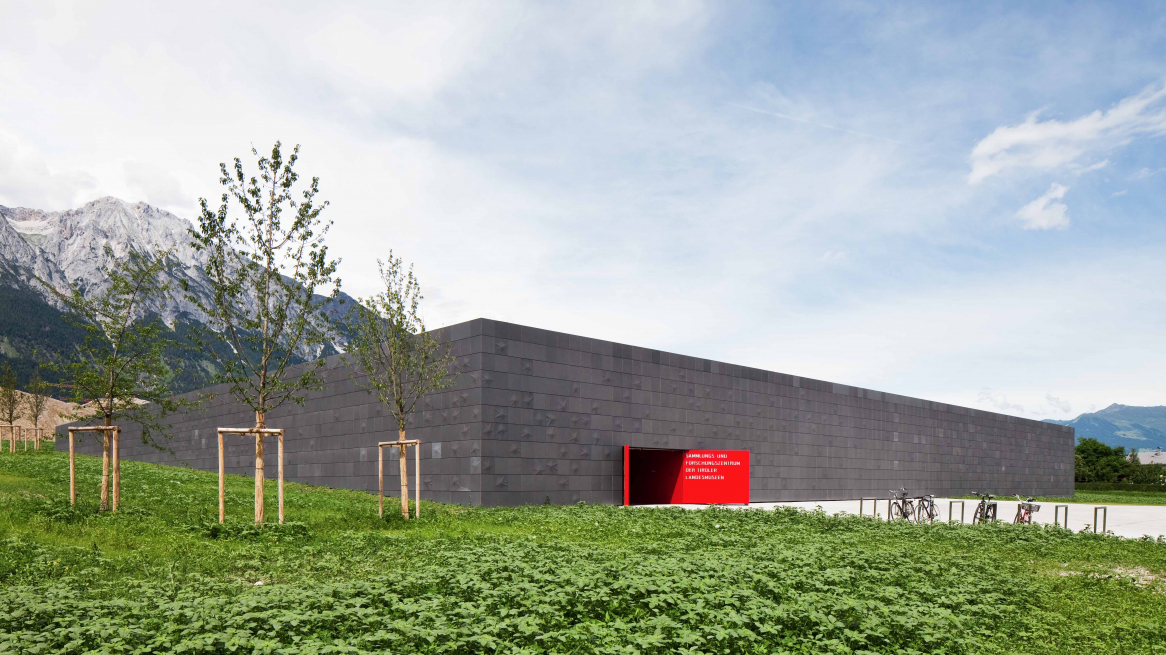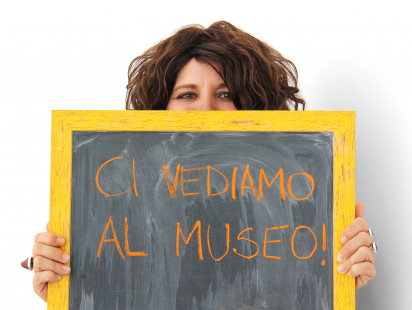
Visiting a museum one rarely realizes one thing: the works and objects on display are often only a small part of the collections, which constitute the real wealth of a museum institution. In the case of the Tiroler Landesmuseen (the Tyrolean regional museums), which have five exhibition venues in Innsbruck, the collections are stored and studied in one place, which is both a storage facility and a center for restoration and research. The building, which opened in 2017, is located in Hall in Tirol: its name is Sammlungs- und Forschungszentrum or, as insiders call it "to make it quicker," simply SFZ. Like all repositories, it is not open to the public, but on some occasions it is possible to visit it.
Few people know that only a small portion of the regional museums' collections are on display. The other millions of objects are stored at Sammlungs- und Forschungszentrum in Hall in Tirol © Christian Flatscher
Beyond the depot door
From the inner courtyard, you can see how the building is developed on three floors, but below street level © Christian Flatscher
The depot and research center of the Tyrolean Regional Museums is a modern building with an area of about 8,000 square meters. It is spread over several levels, although at first glance there would appear to be only the ground floor. In fact, to reduce the impact on the landscape, for climatic and safety reasons, the building is two-thirds below street level. Spread over three floors are the various departments (the restoration, archaeology and natural sciences in addition to the carpentry laboratory) with their respective offices, laboratories and storage rooms. More than 40 people work there every day.
Store millions of objects
The objects, works of art and natural heritage preserved here number in the millions-the precise number has never been calculated and is perhaps not even that important. The collections of the Tyrolean museums are as varied as its exhibition venues - the Ferdinandeum, the folk art museum with the court church, the Tirol Panorama at Bergisel and the museum in the arsenal. So in the collection are archaeological remains and paintings, folk art objects and sculptures, furniture and technical equipment, photographs and works on paper, herbaria, minerals, animal specimens and taxidermic preparations, just to name a few categories.
For example, the oldest herbarium made in Austria is an item from the botany collection kept in this repository. Ippolito Guarinoni, a native of Trento and a physician in Hall in Tirol, created it between 1610 and 1630 for use in the preparation of medicines.
The depot for paintings at Sammlungs- und Forschungszentrum of the Tyrolean regional museums © Christian Flatscher
Every object wants its own "climate"
Different objects require different climatic conditions, and for this reason, there are different deposits. More than temperature, ideal conditions have to dowith humidity. Because, if you need 50 percent humidity for a painting, the percentage drops to 30 percent for metal objects and, in general, for archaeological finds.
Everything is designed for the well-being of the objects in the collection, which must be safeguarded and preserved. For example, if a "new" object comes into storage, it has to spend time in quarantine and under observation, not only to acclimatize, but also to be sure that it does not bring unwanted guests, such as parasites or spores, into the deposits.
The restorers who work here specialize in different materials; so there are those who deal only with textiles and those who deal with paintings, those who deal with paper and those who deal with archaeological finds. It is always very interesting to see them at work, and it is fascinating to think that they "work" on objects that may be contemporary or get to be several thousand years old.
From this repository also depart works from the collections that are loaned to other museums around the world.
And again, to give another example, this time from the botany collection, the oldest herbarium made in Austria is kept in storage. Ippolito Guarinoni, a native of Trento and a physician in Hall in Tirol, created it between 1610 and 1630 for use in the preparation of medicines.
Minerals and taxidermic preparations are stored in Sammlungs- und Forschungszentrum of the Tyrolean regional museums. Photo left © TLM
Photo at right © Christian Flatscher
Useful information
The Sammlungs- und Forschungszentrum of the Tyrolean regional museums is located in Hall in Tirol, Krajnc-Straße 1. It is a place of conservation and research and is not normally open to the public. On some occasions-for example, for the Research White Night-it is possible to visit it. To be updated on the next public opening I recommend checking the Tiroler Landesmuseen website.
It is also possible to book guided tours for groups. You can find all the information here.
And finally, there is a video (in German) that takes you inside Sammlungs- und Forschungszentrum, if you have become curious ...
Rate this article
Show me the location on the map
A visual artist from Milan who not only works with brushes and canvases but also loves writing about art, culture, music, design and creativity.
Similar articles
Innsbruck is really good at beauty! But where a building site is currently disrupting the…
Innsbruck is a popular tourist destination. The big attraction remains the mountains, but the city has a…
Not just looking at art, but getting to know it better on a guided tour, talking about…
The 'Path of the Senses' from Rietz via Stams to Mötz-Locherboden is an exploration in the…










